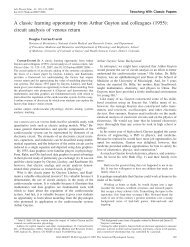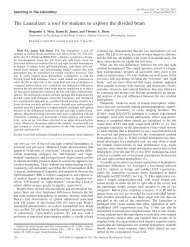construction of a model demonstrating neural pathways and reflex arcs
construction of a model demonstrating neural pathways and reflex arcs
construction of a model demonstrating neural pathways and reflex arcs
Create successful ePaper yourself
Turn your PDF publications into a flip-book with our unique Google optimized e-Paper software.
I N N 0 V A T I 0 N S A N D I D E A S<br />
interneuron<br />
or associatior<br />
neuron<br />
sensory neuron<br />
incoming f<br />
l\;;g:Ttion<br />
~goingfl~~-LM~~~~or<br />
-I<br />
dorsal (back) side<br />
tract containin<br />
motor neuron information<br />
information<br />
ventral (front) side<br />
FIG. 8.<br />
Schematic representation <strong>of</strong> different directions information travels in<br />
the spinal cord. On the left half <strong>of</strong> the spinal cord, the horizontal direction<br />
<strong>of</strong> information travel in the spinal cord is shown. Information comes in<br />
from the sensory neuron to the dorsal (back) side <strong>of</strong> the spinal cord.<br />
Information is passed by an interneuron to the motor neuron. Motor<br />
information leaves the spinal cord from the ventral (front) half <strong>of</strong> the<br />
cord. On the right half <strong>of</strong> the spinal cord, sensory information in an<br />
upgoing tract is found in the dorsal half <strong>of</strong> the spinal cord. This tract<br />
continues upward through the spinal cord to the thalamus <strong>and</strong> then the<br />
cerebral cortex. In the ventral half <strong>of</strong> the spinal cord, motor information<br />
in a downgoing tract is found. This tract originates in the cerebral cortex<br />
<strong>and</strong> descends to its target.<br />
deep touch. Other tracts carry information about limb<br />
position. Descending tracts carry motor information<br />
destined for muscles, visceral organs, or gl<strong>and</strong>s in the<br />
periphery. There are many different tracts in the<br />
spinal cord.<br />
The different directions <strong>of</strong> information travel within<br />
the spinal cord are like people riding an escalator <strong>of</strong> a<br />
busy skyscraper. People (information) can get on <strong>and</strong><br />
<strong>of</strong>f at different floors (levels <strong>of</strong> the spinal cord). They<br />
can also ascend <strong>and</strong> descend in an escalator. To speed<br />
up efficiency, different pr<strong>of</strong>essions ride their own set<br />
<strong>of</strong> escalators. Likewise, different types <strong>of</strong> information<br />
have their own tracts. Different types <strong>of</strong> sensory<br />
information have their own upgoing tracts (up escala-<br />
tors) in the dorsal (back) half <strong>of</strong> the spinal cord, <strong>and</strong><br />
motor information has its own downgoing tracts<br />
(down escalators) in the ventral (front) part <strong>of</strong> the<br />
spinal cord.2 A pictorial representation <strong>of</strong> the different<br />
directions <strong>of</strong> information travel in the spinal cord is<br />
found in Fig. 8.<br />
8) -+Describe the two directions that information can<br />
travel within the spinal cord.<br />
9) *How does information travel in neurons?<br />
2 Some students may feel that an elevator would be a more<br />
practical approach to efficiency <strong>and</strong> to this example. However,<br />
an elevator can travel both upward <strong>and</strong> downward. When<br />
information travels in a tract, it travels in only one direction:<br />
upward or downward like an escalator, not in both directions<br />
like an elevator. Information cannot “ride” the same tract to<br />
ascend <strong>and</strong> descend. Sensory information travels upward in<br />
tracts located in the dorsal (back) half <strong>of</strong> the spinal cord, <strong>and</strong><br />
motor information travels downward in tracts located in the<br />
ventral (front) half <strong>of</strong> the spinal cord. Therefore, the example <strong>of</strong><br />
an upgoing or downgoing escalator is preferred.<br />
VOLUME 16 : NUMBER 1 - ADVANCES IN PHYSIOLOGY EDUCATION - DECEMBER 1996<br />
s21<br />
g









